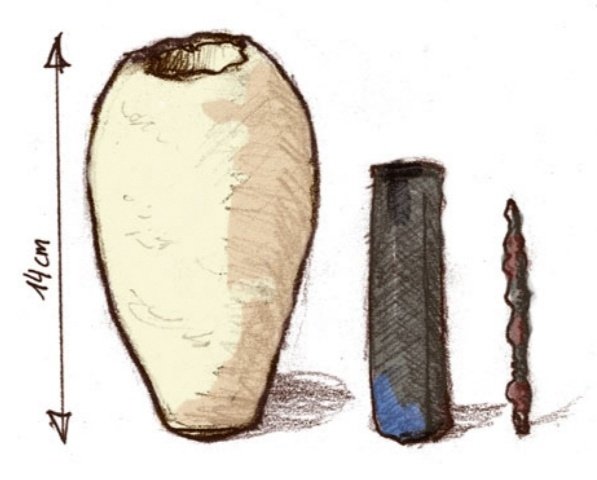Some extraordinary archaeological finds have proved that our ancestors were more advanced than we think. They acquired such knowledge beyond the timeline, baffling even today’s cutting-edge researchers and scientists. The Baghdad Battery is just one such example.
In 1938, the German archaeologist Wilhelm Konig found a strange-looking ancient clay jar and others like it as part of a collection in the National Museum of Iraq attributed to the Parthian Empire. This ancient Asian culture ruled most of the Middle East from 247 BC to AD 228. Later in 1940, Konig described the 2,200-year-old clay jar as the oldest known electric battery in existence. The jar itself has been dated to sometime around 200 BC. While some claim, Konig dug the clay jar up himself from an archaeological site in Iraq.
Here’s Why The 2,200-Year-Old Clay Jar Is Called Baghdad Battery:
Those who’ve examined the clay jar closely say that several things indicate it to be a “wet cell” or “battery.” The nondescript earthen pot is only 5½ inches high by 3 inches across. The opening was sealed with an asphalt plug, which held a copper sheet, rolled into a tube. This tube was capped at the bottom with a copper disc held in place by more asphalt. A narrow iron rod was stuck through the upper asphalt plug and hung down into the center of the copper tube — not touching any part of it. That’s why the ancient Iraqi clay jar has been popularized as the “Baghdad Battery.”
The Inner Workings Of The Baghdad Battery:
If the jar is filled with an acidic liquid, such as vinegar or fermented grape juice, it turns into a battery capable of generating a small amount of current. The sour liquid permits a flow of electrons from the copper tube to the iron rod when the two metal terminals are connected. This is the same principle that was discovered by Galvani 2,000 years later and that Alessandro Volta successfully harnessed into the first modern battery a few years later.
What Was The Battery Of Baghdad Used For?
Researchers conducted various experiments with models of the Baghdad Battery. As a result, they were able to generate electricity between 1.5 and 2 volts from the models. It’s not a lot of power. However, researchers are still puzzled that what batteries would have been used for nearly 2,200 years ago!
Many have explained the use of the Baghdad Battery, saying that the Greeks and Romans used certain species of electric fish to treat pain. They’d stand on a live electric eel until their gout-pained feet went numb. Therefore, the battery was perhaps used as a ready source of less slimy analgesic electricity (Electroanalgesia).
Other theories hold that several batteries could have been linked together to generate a higher voltage for electroplating gold to a silver surface. More experiments with several Baghdad-type batteries have shown this to be possible.
Interesting Facts That You Should Know About The Battery Of Baghdad:
- The Baghdad Batteries are terracotta pots that are approximately 115 mm to 140 mm tall.
- Though Wilhelm Konig, the German archaeologist who was the director of the National Museum of Iraq, is widely believed to discover the Baghdad Batteries in the museum’s collections in 1938, it is uncertain whether Konig dug it up himself or found it archived in the museum.
- Wilhelm Konig was among the first to speculate that these 2200-year-old ancient clay jars were, in fact, batteries in a paper published in 1940.
- It was believed that the batteries were used in ancient times for electroplating gold onto silver objects or as a ready source of less slimy analgesic electricity. Until today these claims have not been proven, and there is no conclusive evidence to support these theories.
- Ancient peoples in Mesopotamia used a process called “fire-gilding” for decorative purposes.
- Ancient Astronaut theorists suggest that ancient Egyptians were very familiar with the Baghdad Batteries. According to their theory, the batteries might have been used to provide light in the chambers of the pyramids and other such secret places. But this theory also has no evidence backing it up. To this day, no written texts have been found anywhere that would suggest the use of electricity in such a way in ancient times, at least not with the “Baghdad Batteries.”
- If these Iraqi artifacts were used as batteries, they would predate Alessandro Volta’s electrochemical cell by a millennium.
- Researchers that support the theory about the terracotta pots being ancient batteries suggest that fermented grape juice, lemon juice, or vinegar was used as an acidic electrolyte to generate a small amount of electric current, which was not more than 2 volts.
- Even though there are very few documented experiments with the Baghdad Batteries, in 1978, Dr. Arne Eggebrecht from the Pelizaeus Museum in Hildesheim had conducted a few experiments with Baghdad Battery models (replica) using grape juice as an acidic liquid and thin layers of silver, which supposedly resulted in the production of electricity.
- Elizabeth Stone, a professor at Stony Brook University and an expert on Iraqi archaeology, states that these artifacts were no batteries. She disagrees completely with anyone trying to suggest otherwise.
- Given the descriptions of the Baghdad Batteries, these were sealed at the top with metal pieces, so it would have been nearly impossible to connect them to anything even if they did produce electricity unless the design was altered.
- No wires or any conductors have been found or associated with the Baghdad Batteries.
- Several other artifacts resemble the Baghdad Batteries found throughout ancient Mesopotamia, mainly used to store papyrus.
- Research suggests that rotted papyrus scrolls placed inside these vessels might have caused acidic organic residue.
So, what’s your thought about the “Baghdad Battery?” Is this a battery that was used to generate electricity in ancient times? Or, it’s just a kind of terracotta pot to hold papyrus scrolls?



























